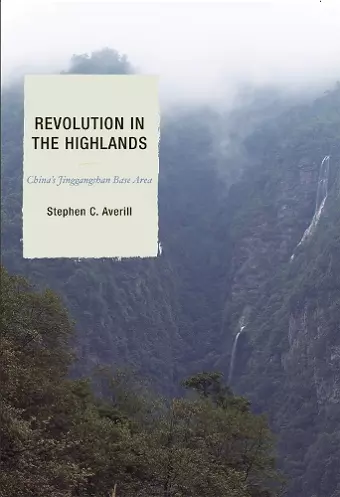Revolution in the Highlands
China's Jinggangshan Base Area
Stephen C Averill author Joseph W Esherick author Elizabeth J Perry author
Format:Hardback
Publisher:Bloomsbury Publishing PLC
Published:6th Nov '06
Currently unavailable, and unfortunately no date known when it will be back

This extensively researched and elegantly written study offers a fine-grained analysis of the origins of the Chinese Communist Revolution in the countryside. Building on decades of research in newly available sources and multiple trips to Jiangxi, Stephen Averill provides a definitive local perspective on the rise of a revolution that reshaped China and the world. A rich work of social history, it goes beyond recently popular organizational approaches to explore the ways in which the party and social networks interpenetrated and interacted in the early stages of revolutionary base-building.
The Jinggangshan highlands provided the base for Mao Zedong's first efforts at rural revolution. Chinese histories and most Western accounts have focused on the heroic exploits of Mao and his Communist Party comrades, battling the natural elements, hostile military forces, and skeptical authorities in the urban-based Communist Central Committee. This long-awaited work penetrates the hagiographic haze of Mao-centered analysis to provide a close narrative and rich social history of the Jinggangshan base. The author explores the historical patterns of local strongman rule, clientelist politics, lineage conflict, and ethnic struggle within which the party competed for power. Through this multifaceted lens, the revolutionary experience in Jinggangshan is equally dramatic but considerably more sobering than the conventional story.
Among Western studies of the Chinese revolution, this work stands out as the definitive account of the critical moment in the 1920s when the physical and ideological center of the Communist movement shifted from the cities to the countryside. This was a process of elite-mediated political osmosis and adaptive compromises with local traditions. The party was not simply an outside force manipulating social tensions for its own political ends. There was, instead, an intricate interweaving of local networks and social cleavages in the highlands with the political structures and policy divisions of t
Stephen Averill’s monograph on this subject has been long awaited, and the wait has been worthwhile. The depth and sharpness of the scholarship, and the highly complex social ecologies and turbulent histories it documents, make Revolution in the Highlands a study for all scholars who work in the fields of modern and contemporary Chinese studies. -- Pauline Keating, Victoria University of Wellington
Stephen Averill made himself master of the details of the Communist experience in Jinggangshan. This rich, dense study critically examines how the environmental and social context of the Jinggangshan region shaped the politics and strategy of Mao and other local leaders. . . . Highly recommended. * Choice Reviews *
an important work, one of the best available on the early history of the communist revolution in rural China....we may be grateful to Joseph Esherick and Elizabeth Perry for undertaking to edit the book for publication posthumously, as well as the splendid introduction they have provided to go with it. * China Information *
this rich and insightful study has...set a new standard for analyzing the Chinese Communist Revolution. * American Historical Review *
This is the most sophisticated analysis yet written on the early rural revolution and base-area building, and the book stands as a major contribution to the understanding of Chinese Communism....Stephen Averill lifts the Communist revolution into a new, exciting dimension. * The China Journal *
This is one of the best books yet on Chinese Communism in its early rural period, written from a wealth of sources by a master of historical exposition. So familiar is the author with the political anthropology and physical features of the highlands in which Mao Zedong and his comrades hatched their revolution that he writes about it almost as an insider, restoring depth and complexity to events reduced to parody by party drillmasters and hagiographers. He analyzes the particular issues of the party’s sojourn in the Jinggang Mountains in the late 1920s and early 1930s against the background of the broad sweep of the Chinese revolution, which he illuminates with insights into the moment of birth of its unique style. -- Gregor Benton, University of Wales, Cardiff
Anyone interested in the formative years of the Chinese Communist Party will be richly rewarded by this lengthy, well-argued and nuanced study of the Jinggangshan base area in the late 1920's: this is a work that will be cited for years to come as well as a fitting legacy for a superb scholar. -- . * China Quarterly *
ISBN: 9780742528789
Dimensions: 235mm x 154mm x 32mm
Weight: 755g
488 pages